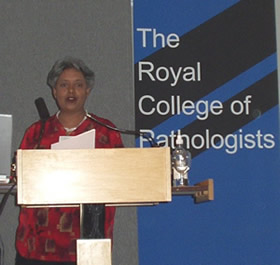 |
||||||||||
Date: May 24, 2026
by Chaya Venkat
Related Articles on HuMax-CD20


Harvey and Serena are back after their CLL adventures in UK, and here I am continuing to write up the saga of our favorite fictional patient and Round-Headed-Kid. For those of you who are not familiar with this story, get yourself a beer, settle down in a comfortable chair and look up the link given below. Some of you may think there is an uncanny resemblance between my husband PC and Harvey, blessed if I know why.
Here is the link to the Harvey Saga page where you can see all the prior articles in this serial case history.
A brief recap for your convenience: Harvey is unfortunate in that he has 11q deletion, a chromosomal aberration that puts him in a high risk and poor prognosis category. The good news was that he responded extremely well to Rituxan therapy (with a few low impact and non-toxic adjuvants, such as fish oil, green tea extract EGCG and vitamin D3). Almost too well, it turned out. As we discovered in our recent update, Rituxan Road-Block, Harvey developed delayed onset hypersensitivity to Rituxan, a bad case of dermal and mucosal inflammation. No more mouse juice for him, ever! The chimeric monoclonal antibody (chimeric just means that part of the Rituxan molecule is a mouse protein, and part of it is human, the reason why some patients affectionately call it "mouse juice") is a very important drug in our arsenal, and developing serious allergic reaction to it is definitely bad news. Just about all our modern chemo-immunotherapy combinations have Rituxan in them, the exceptions being those that use Campath instead. Serena (Harvey's decidedly better half) would not hear of using Campath at this point. She wanted to save this big gun for a later stage.
How does one finesse the need for anti-CD20 monoclonal antibody, without resorting to Rituxan? That would have been a non-starter just a short while ago. Not so now. There is a new kid on the block, a new monoclonal antibody that also targets the CD20 marker on B-cells. But there is one big difference, this monoclonal (HuMax-CD20 Clinical Trial) is entirely human with no mouse protein in it. With any luck, the hypersensitivity that Harvey developed to Rituxan was specific to it alone, and the new, fully human monoclonal antibody from Genmab would not trigger the same reaction. That is our theory, and we are sticking to it, for now. Time will tell if there is delayed reaction to HuMax-CD20 as well. I am keeping my fingers, toes and eyes crossed for Harvey!
But Harvey soon found that it was one thing deciding on the drug he wanted to use, but whole another matter to actually get the therapy. To make a long story short, Genmab was extraordinarily generous in granting Harvey access to their drug on a "compassionate use" basis, but red-tape meant he had to get it administered in the UK. Harvey and Serena packed up and went to Bournemouth and the HuMax-CD20 was administered in due course, under the watchful eye of our own Dr. Terry Hamblin.
Here was the game plan, in terms of the drugs used, dosages, details of sequencing, etc.
HuMax-CD20: Four weekly infusions, the first one a wimpy 300 mg, followed by three more "manly" size infusions of 1,000 mg each. For those of you who like to keep track of such details, Harvey prior treatments had been 8 weekly infusions of Rituxan, 700 mg each time. The comparison is therefore a total of 3,300 mg HuMax-CD20, versus 5,600 mg Rituxan. The pre-medications used were similar in both cases: Tylenol, Benadryl.
Chlorambucil: Harvey wanted a longer remission this time around. His Rituxan remissions used to last about 12 months but they had been getting shorter, more along the lines of 8-10 months recently. Harvey did not want to revisit therapy decisions again any time soon. The total amount of the HuMax-CD20 proposed for his treatment was less too (see comparison of dosages above), over a period of only four weeks compared to his usual 8 weeks of Rituxan. For all of these reasons, the decision was made to add a new drug to the mix, namely the "old-fashioned" chlorambucil (trade name "Leukeran"). But to try and limit any potential toxicity of this chemotherapy drug, it was decided that Harvey would get the chlorambucil at very low dosage, 3.5 mg/m2. Harvey got to take the chlorambucil for 14 days on and 14 days off, for two cycles. He started the chlorambucil on the same day that he started the first Humax infusion.
Dexamethasone: This drug is a glucocorticosteroid, similar to prednisone and methyl prednisolone. Unlike the methyl prednisolone which is given as an infusion, dexamethasone can be taken orally as a pill. The reason for including the dexamethasone was very simple. No one wanted a repeat of the hypersensitivity reaction, and this was insurance. Dexamethasone, like all steroidal drugs, has a dampening effect on the immune system. It was hoped the dexamethasone would keep things from getting blown out of proportion. The dosage was again kept low: 10 mg of it for four days each week, starting with the first Humax infusion. Both the chlorambucil and dexamethasone dosages were kept low, compared to normal practice, at Harvey's request.
There was just a little bit of excitement, on the day of the first infusion. Everything was going along swimmingly, and Dr. Hamblin decided to go for a much delayed lunch. As Murphy's law would have it, all hell broke loose right after. Serena noticed a small red patch on the back of Harvey's neck. As she bent over to look at it more closely, in a matter of minutes the redness spread to his back, chest, legs and arms. He looked like a well-boiled lobster! The emergency call button was pressed, nurses rushed in, the infusion pump was turned off promptly and Dr. Hamblin was summoned back to the hospital. Believe me, it was scary for while! A phone call to Genmab in Denmark was initiated. The company's experts were in a meeting, but this was deemed sufficiently important that the meeting was interrupted. Yes, they had seen this response before in other patients. And no, it was not thought to be dangerous. The name for it is urticaria (hives, in plain English. I wonder how you say hives in Danish). It was suggested that Harvey wait until the hives subsided, and then the infusion started up again, very slowly, while keeping a watchful eye for any tendencies to boiled lobsterism. This time around, everything went smoothly. The only complaint was that the infusion was so slow that it went on until close to midnight. Not that any one was complaining, Harvey and Serena were grateful that there was no further excitement.

The next three infusions were a piece of cake, no alarms, no excitement. It was nice to be pampered in the spacious private rooms of the Nuffield Hospital. Charming nurses coming by every now and then, to ask if you wanted a cup of tea, how about some biscuits (cookies) to go with that? But no scones, strawberry jam or clotted cream though. Serious deficiency, they should do something about that. Harvey's CBC was perfectly in the pink right after the first infusion. And the lumpy nodes began to melt away. Serena said Harvey looked like a caricature of an axe murderer before his treatment, with his hugely swollen neck, but soon after his therapy started Harvey's neck reverted back to its normal swan-like appearance. Hey, whether a neck is scrawny or swan-like, it is all in the eye of the beholder.
A more telling change was in Harvey's ability to exercise. As a devoted runner, Harvey had been worried when he could run barely two miles in the days before his HuMax-CD20 therapy started. His lungs just could not pump hard enough against all those swollen lymph nodes in his chest. After the second infusion, he surprised himself by running 13 miles along the beachfront promenade in Bournemouth, from Poole to Hengistbury Heights! Just to make sure, he did it again, two days later. No question about it, the Round-Headed Kid was back to fighting trim!
Now if he could only avoid delayed onset inflammation, hypersensitivity and the like, and hang on to the remission for a good long while. We can but hope.
PC and I happened to be in the UK — mainly to keep an eye on Harvey and Serena, give the nice kids some moral support. But that definitely was not all. Besides getting a little sightseeing done — castles, cathedrals, dramatic white cliffs — we also we sampled scones, clotted cream, and cucumber sandwiches. There are indeed many pleasures to be sampled in this beautiful part of the UK.
 We also had the pleasure of meeting some of our UK members. Our sincere thanks to Howard Pearce (founder and trustee of the UK CLL Support Association) and his charming wife Andrea for hosting the meetings at their lovely home in Romsey. Friendships forged during these meetings led to this new fledgling organization deciding to join CLL Topics in sponsoring and funding the latest clinical trial we announced recently (see: Improving Immunizations).
It also happened that our visit coincided with a scheduled meeting of the UK CLL Forum, sort of the UK version of our own CLL Research Consortium. The Forum is open to CLL experts as well as patients. How wonderful is that! I wonder what it will take to get our own CRC to throw their meetings open to mere patients. Something tells me I had better not hold my breath on that one. I was honored to be one of the speakers at the Forum.
We also had the pleasure of meeting some of our UK members. Our sincere thanks to Howard Pearce (founder and trustee of the UK CLL Support Association) and his charming wife Andrea for hosting the meetings at their lovely home in Romsey. Friendships forged during these meetings led to this new fledgling organization deciding to join CLL Topics in sponsoring and funding the latest clinical trial we announced recently (see: Improving Immunizations).
It also happened that our visit coincided with a scheduled meeting of the UK CLL Forum, sort of the UK version of our own CLL Research Consortium. The Forum is open to CLL experts as well as patients. How wonderful is that! I wonder what it will take to get our own CRC to throw their meetings open to mere patients. Something tells me I had better not hold my breath on that one. I was honored to be one of the speakers at the Forum.
If you want to see my presentation and read what I had to say, click on the following link to a pdf verson of my presentation: CLL Forum Presentation. I had an attentive and friendly audience, lots of questions at the end of the presentation. It also gave me an opportunity to make new friends in the UK CLL expert community - some of them have already agreed to become members of our unofficial expert advisory board. Many thanks to Dr. Hamblin for inviting me and PC to the meeting, and giving me a chance to speak as well.

I am sure some of you are thinking it is all well and fine for Harvey to get HuMax-CD20 on compassionate use basis, but how about the rest of the folks out there? I am happy to report that Genmab has just announced a new clinical trial of their fully humanized monoclonal antibody. You can click on the link here to read the Company's announcement, hot off the presses: Genmab Announcement
Bottom line, I am very pleased there is a new drug that might make it to market soon, a drug that can give Rituxan a run for its money. A two horse race is always more fun, and perhaps a little healthy competition will encourage Genentech to support more research into improving Rituxan, and lead both companies to consider less hefty price tags for their drugs. There is certainly an unmet need for a CD20-targeting monoclonal antibody that works well as a single agent in CLL, without having to add on chemotherapy drugs to boost its oomph, and works in patients who have been around the block a few times in terms of prior chemotherapy. Rituxan does not fit that bill. Its response statistics as a single agent in previously treated patients is well documented and pretty disappointing. As for the delayed onset adverse effects (such as delayed onset neutropenia, hypersensitivity, and the rare case of potentially life threatening Stevens Johnson Syndrome), only time will tell if the fully humanized HuMax-CD20 will do much better. That is the whole point of post marketing surveillance, to learn from long term use of new drugs details that cannot be learned from short term clinical trials.
We wish Genmab great success in their new clinical trial.
 Enter Keywords: |
———
Disclaimer: The content of this website is intended for information only and is NOT meant to be medical advice. Please be sure to consult and follow the advice of your doctors on all medical matters.
Copyright Notice:
Copyright © 2026-2007 CLL Topics, Inc. All Rights Reserved.
All materials contained on this site are protected by United States copyright law and may not be reproduced, distributed, transmitted, displayed, published or broadcast without the prior written permission of CLL Topics, Inc. You may not alter or remove any trademark, copyright or other notice from copies of the content.
However, you may download and print material from CLLTopics.org exclusively for your personal, noncommercial use.
———
